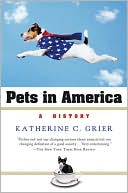

 |

|

The average rating for Pets in America: A History based on 2 reviews is 4.5 stars.
Review # 1 was written on 2021-02-11 00:00:00 Matthew Uhl Matthew UhlHighly readable and insightful. Her broad definition of pets allows her to explore a variety of topics in the history of human- animal relationships. |
Review # 2 was written on 2012-07-16 00:00:00 Daniel Oberreuter Daniel OberreuterKatherine F. Grier's Pets in America is a fascinating account of how our patterns of behaviour have changed over three centuries with regard to the species we live with and the reasons we do so. In the 1700s and 1800s, Americans shared their homes and properties, as well as the city streets where they lived, with a greater number of species (e.g., cats, dogs, cows, chickens, pigs, horses) than we do today even though 'more than 60 percent of American households contained pet animals.' (p. 315) In this country's short history, the numbers of animals, companions or otherwise, that it has consumed is beyond comprehension. For example, Grier notes that the number of canaries imported into the U.S. was 'more than 20,000 in the decade before 1853, 10,000 in 1853 alone, and 20,000 each year by 1867.' (p. 241) America's pets is big business, which Grier charts with great detail over the centuries. Surprisingly, today, she states that as a 'percentage of the entire American economy, with a $10.4 trillion gross domestic product in 2002, the pet industry is small [$34.4 billion].' (p. 316) Nonetheless, all these millions of animals who were seen to be a 'fancy' ' an earlier term for a pet or companion animal, they are all individual animals each one with a unique personality. Indeed, one of the most interesting aspects to Grier's book is how she charts the transition from the anonymity, if you will, of the chickens and pigs who people used to live alongside with to the emergence of a 'biography' and identity for those animals who became people's pets. She quotes many fascinating accounts written over the years about how people described their relationship with the animals they lived with. In the course of this history, Grier refers to the emergence of humane attitudes, including in fiction (e.g., Black Beauty by Anna Sewell) and education, and the origins of animal control and the animal protection movement, including the ASPCA. There is also an important narrative on the development of the pet food and supplies industry. This is an important book for animal advocates and animal scholars to read. It makes an major contribution to our understanding of how and why our relationship with those animals who we designate as 'pets' is a mess -- even though for many of us they are the loves of our lives. |
CAN'T FIND WHAT YOU'RE LOOKING FOR? CLICK HERE!!!